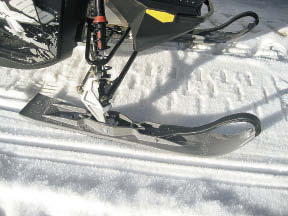 First impressions are usually right. The first time we hit the snow with a set of Curve skis on our Summit 600, we knew we had something good going. They were easy to turn and very responsive . actually, almost too responsive.
First impressions are usually right. The first time we hit the snow with a set of Curve skis on our Summit 600, we knew we had something good going. They were easy to turn and very responsive . actually, almost too responsive.
After some fine-tuning on the sled's ski pressure (letting out the limiter strap as far as it would good) the sled handled like a dream down the trail and floated through what powder we were able to find this past season.
Now you could blast down a trail in total control, bounce out into the powder and still have positive steering on the snowmobile. That's because the Curve Ski is designed with a "snow control" profile that compresses snow into rails under the ski.
What that means is somewhat technical. But basically, if you were to turn the ski over and look at how the contours come together, there is a wide, high surface area intake profile at the tip of the ski which transitions into a narrow, low surface area in the center of the ski. So as the ski passes over the snow, it grabs what loose snow it can on the intake profile and funnels it into a compressed rail of snow on each side of the wear bar. The ski then rides on the two rails of snow, not the bottom of the rutted trail. When you enter a corner, the ski uses the rails it has already formed to push off from, which gives the skis outstanding cornering performance.
However, when you ride off trail, this compression principle doesn't work because there is no compacted base to compress against. Instead what happens is another design principle the Curve designers call tip up.
Since the Curve skis have a dynamic cross section where the front is wider than the center and back, the skis have more flotation up front than in the center. This encourages the ski to always climb on top of the snow. Too much climbing could result in plowing or the inability to plane on top of the snow. Too little tip up could result in the inability to float on top, again resulting in plowing. The right combination allows the Curve ski to get on top fast and then float across the powder.
On a hard crust snow, the ski will have issues if you try to pull it up on a side and ride its edge (there are some competing edges on the side profile of the ski that makes it unpredictable on hardpack snow). But in most snow conditions you don't deal with these competing edges.
Also, in wet fresh snow on a hardpack trail the compression rail can be so compacted that it takes great effort to turn (we experienced this in spring riding conditions). And we also found that the hand hold in the ski loop can be rather uncomfortable when pulling out a stuck sled.
The Curve ski is also designed with an x-beam mounting structure that serves as a spindle mount while providing deflection control. The ski tip is designed to flex rather than absorb the bumps. The ski is designed to be compatible with the StudBoy 2198 Series wear bars or carbides in either 10-or 17-inch lengths.
A complete package of skis and loops with mounting assembly hardware and carbides costs just more than $500.
For more information contact www.curvexs.com.